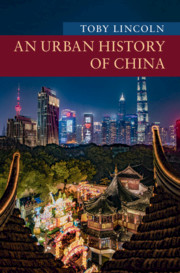Book contents
- An Urban History of China
- New Approaches to Asian History
- An Urban History of China
- Copyright page
- Contents
- Figures
- Maps
- Tables
- Acknowledgements
- Introduction
- 1 The Emergence of China’s Imperial Urban Civilization (Antiquity to 220 CE)
- 2 The Expansion of China’s Imperial Urban Civilization to the South (220–755)
- 3 The Tang-Song Transition and Its Effects on China’s Imperial Urban Civilization (907–1402)
- 4 The Flowering of Chinese Imperial Urban Civilization (1402–1799)
- 5 The Seeds of Urban Modernity (1800–1895)
- 6 Urban Modernity in Republican China (1895–1949)
- 7 The Maoist Period (1949–1976)
- 8 The Reform Era and the Present
- Conclusion
- Index
- Series page
- References
4 - The Flowering of Chinese Imperial Urban Civilization (1402–1799)
Published online by Cambridge University Press: 29 April 2021
- An Urban History of China
- New Approaches to Asian History
- An Urban History of China
- Copyright page
- Contents
- Figures
- Maps
- Tables
- Acknowledgements
- Introduction
- 1 The Emergence of China’s Imperial Urban Civilization (Antiquity to 220 CE)
- 2 The Expansion of China’s Imperial Urban Civilization to the South (220–755)
- 3 The Tang-Song Transition and Its Effects on China’s Imperial Urban Civilization (907–1402)
- 4 The Flowering of Chinese Imperial Urban Civilization (1402–1799)
- 5 The Seeds of Urban Modernity (1800–1895)
- 6 Urban Modernity in Republican China (1895–1949)
- 7 The Maoist Period (1949–1976)
- 8 The Reform Era and the Present
- Conclusion
- Index
- Series page
- References
Summary
Chinese late imperial urban civilization was made up of loose regional economies with a few large cities supported by lots of market towns. The Grand Canal remained its backbone, and China’s most prosperous cities were distributed along its length, and international maritime connections to the early modern global economy saw the growth of the Pearl River Delta. Elsewhere defence was important. Ming Dynasty coastal cities faced threats from pirates. Then as the Qing Dynasty expanded into the northwest, cities in the new province of Xinjiang developed around military garrisons. Walls remained a primary characteristic of Chinese urban form, and they surrounded large commercial and administrative cities, as well as those built for defensive purposes. All cities were now governed by a mixture of state and private interests, including the newly established merchant societies. The Ming and Qing Dynasties saw the flowering of late imperial urban culture. The cities of the Lower Yangzi Delta set the standards of style and taste, but the movement of gentry, merchants, and other urban residents brought this urban culture to the farthest corners of the empire. They produced travel guides, urban histories, prose, and poetry that recorded all aspects of urban life in minute detail.
- Type
- Chapter
- Information
- An Urban History of China , pp. 105 - 134Publisher: Cambridge University PressPrint publication year: 2021



